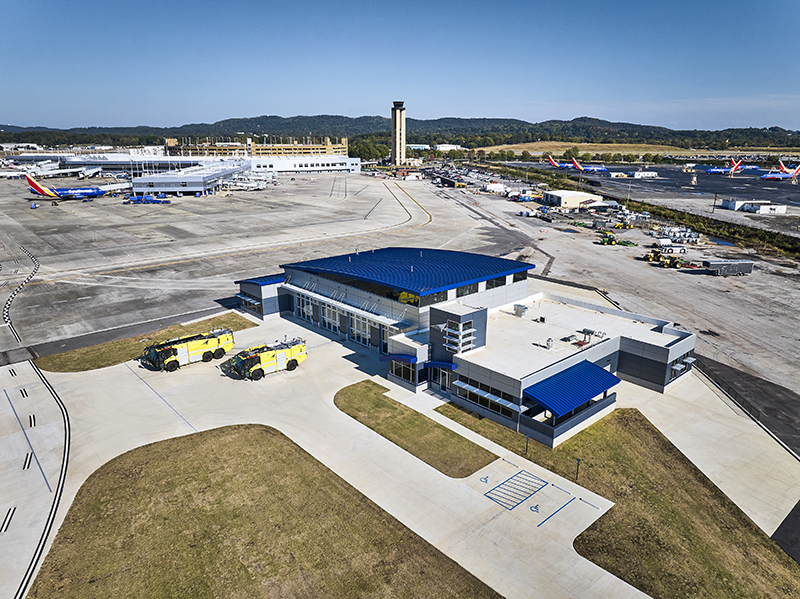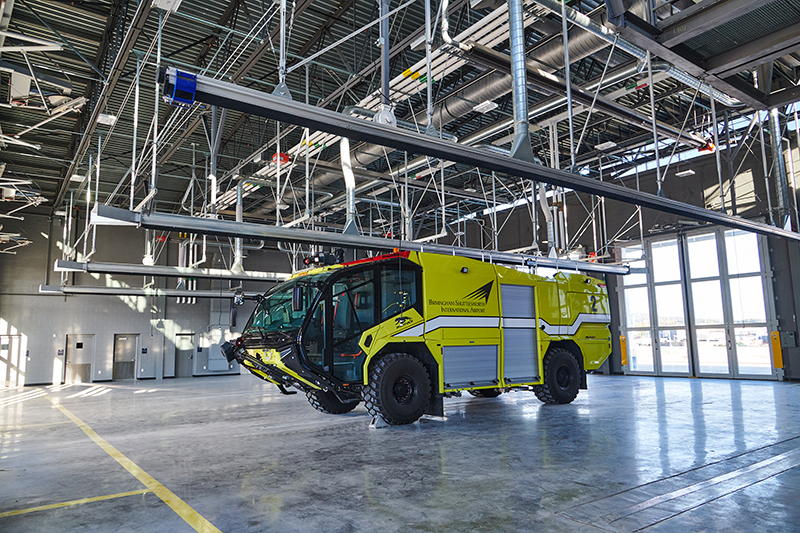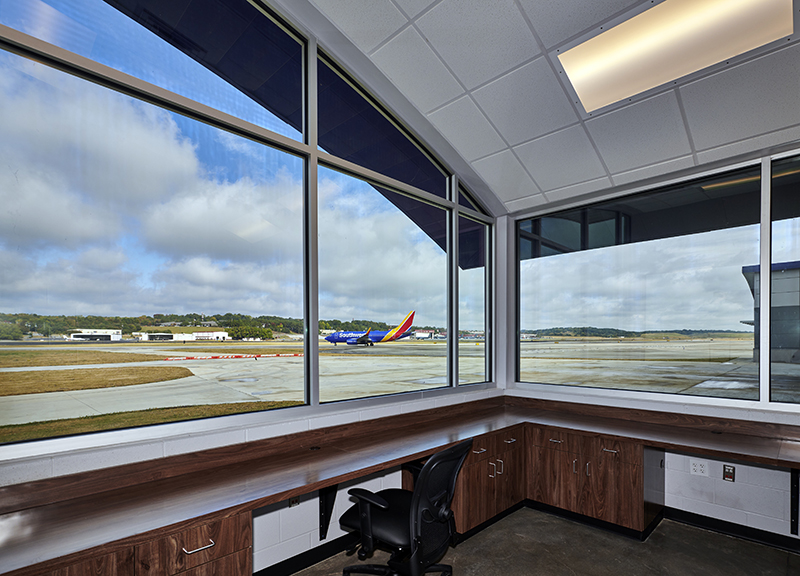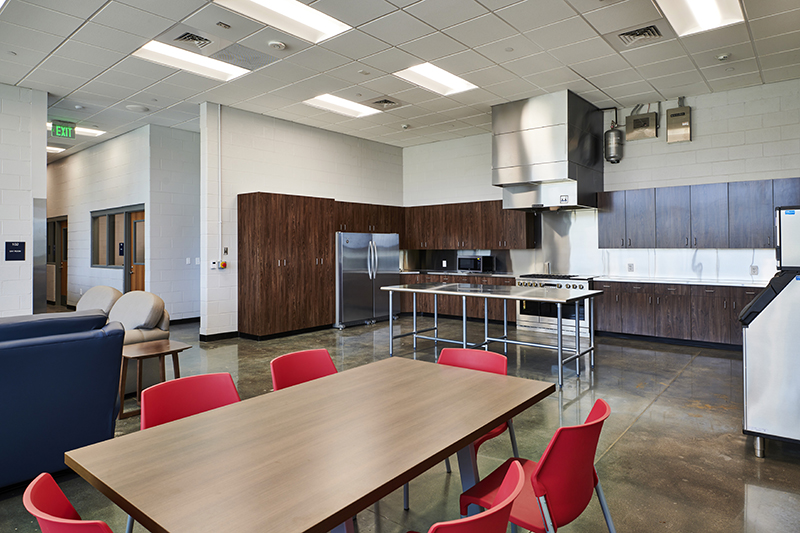Designing and building an aircraft rescue and firefighting (ARFF) fire station has a number of challenges that architects and general contractors have to face that are not present in a typical municipal fire station.
Chief among those challenges is dealing with air restrictions and safety zones on the airfield, as well as working specific hours to eliminate the possibility of affecting flight operations.
Clay Dorsey, president at Dorsey Architects & Associates Inc., says that any time a firm has to design and construct a station on an airfield, it has to abide by Federal Aviation Administration (FAA) regulations. “You have to deal with views and safety zones, be a certain distance away from jet engines so no harm comes to the building you’re designing or the people working in it, there’s a lot of security involved on the airfield, and you often have to work in certain specific hourly time frames,” Dorsey points out. “When pouring concrete, we had to work between 1:00 and 6:00 AM in order to work around scheduled takeoffs and landings.”

1 Dorsey Architects designed the new ARFF station at Birmingham-Shuttlesworth (AL) International Airport. (Photos courtesy of Dorsey Architects & Associates Inc.)

2 The four drive-through apparatus bays at the ARFF station house the airport’s firefighting equipment, including a Rosenbauer Panther 6×6 ARFF truck with an HRET and a Rosenbauer Panther 4×4 ARFF truck (shown in the bay).

3 The watch room at the new ARFF station.
With the design and build of the Birmingham-Shuttlesworth (AL) International Airport ARFF station, Dorsey added that his firm had to work within height restrictions on the station, as well as how far away from the airport control tower the structure must be (32 feet). “We were faced with a lot of setback restrictions from safety zones for the new ARFF station,” he observes. “Added to those challenges, we were working in a flood zone, so the building had to be raised one foot above that flood zone and have a concrete slab much more fortified than a typical municipal fire station, with an apron that is 12 inches thick.”
The resulting ARFF station has four drive-through apparatus bays, with living and office spaces on one side of the apparatus bays and decontamination and gear storage spaces on the other, Dorsey points out. “The regional FAA office had to approve the design of the station,” he says. “We had to study a video of what pilots see when landing because the FAA didn’t want the building and any of its lighting to be a distraction when aircraft are landing. The lighting had to be subdued.”

4 Birmingham’s new ARFF station has an open-concept kitchen/dining/dayroom area.

5 The ARFF station’s exterior is clad in architectural insulated embossed metal panels, which are known for their durability and low maintenance.
Kenneth Hatcher, chief of airport operations for Birmingham-Shuttlesworth International Airport, says his crews at the airport authority’s ARFF station operate on the same guidelines as the Birmingham (AL) Fire Department does, while specializing in aircraft rescue and firefighting. “We have 18 paid full-time firefighters assigned to the airport, and we cover all general aviation and commercial aircraft flights at the airport.” He adds that Birmingham Fire has 707 employees operating out of 32 stations, six of which are within three miles of the outside perimeter fence of the airport.
Hatcher notes that before January 1, 2023, his crews had been housed with the military firefighters of the 117th Air National Guard Refueling Wing on the other side of the runway. “We have operated with them since 1961, and we still respond with them to incidents,” he says. He adds that the airport received a federal Assistance to Firefighters Grant that allowed the airport authority to build the new ARFF station and purchase two new crash trucks—a Rosenbauer Panther 6×6 ARFF truck with a high-reach extendable turret (HRET) with a piercing nozzle and a 3,000-gallon water tank and a Panther 4×4 ARFF truck with a 1,500-gallon water tank.
Dorsey says the new ARFF station’s cold zone has six dorm rooms, one men’s toilet/shower/bathroom, one women’s toilet/shower/bathroom, and two locker rooms in the living area along with administration offices, a kitchen/dining/dayroom, an exercise room, a training room, a conference room, a watch room, and general storage rooms. Total square footage of the new station is 18,000 square feet, with a construction cost of $11 million.
The station’s warm and hot zones include a decon room with extractor and dryer for laundering gear, a turnout gear storage room, a work room, a self contained breathing apparatus (SCBA) storage room, and a training room. “Both the turnout gear storage room and the training room have access from both inside and outside the station,” Dorsey points out. “There’s also a backup generator in a room at the rear of the station, and the apparatus bays have a MagneGrip engine exhaust system.”
Dorsey’s design team made sure the exterior of the station would withstand the rigors of being on an operating airfield. “The exterior is insulated metal panels to match the existing terminal building,” he says. “We chose architectural insulated embossed metal panels for their durability and low maintenance, which is critical for the building’s exterior finish because of the facility being closely located within the proximity of moving aircraft taxiing before takeoff and landing on a daily basis.”
He adds that by choosing a variety of colors, materials, and finishes, his team was able to match the existing terminal. “It allowed us aesthetically to achieve a contemporary and modern look, along with the designed curved and sloped standing seam metal roofs and sleek curved clerestory glass, making the station very maintenance-free.”
ALAN M. PETRILLO is a Tucson, Arizona-based journalist, the author of three novels and five nonfiction books, and a member of the Fire Apparatus & Emergency Equipment Editorial Advisory Board. He served 22 years with the Verdoy (NY) Fire Department, including in the position of chief.

